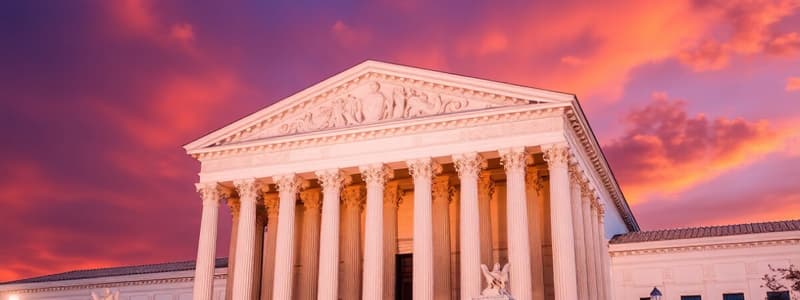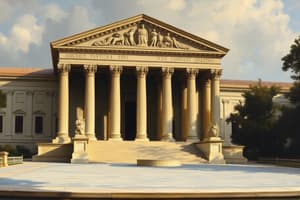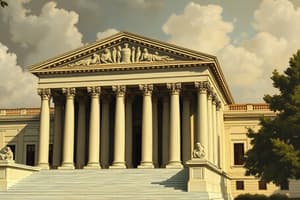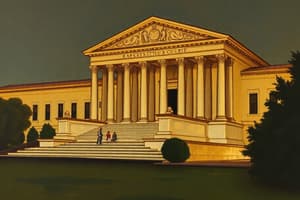Podcast
Questions and Answers
Which article of the U.S. Constitution primarily outlines the structure and function of the Judicial Branch?
Which article of the U.S. Constitution primarily outlines the structure and function of the Judicial Branch?
- Article II
- Article I
- Article IV
- Article III (correct)
What is the significance of the Supreme Court case Marbury v. Madison (1803)?
What is the significance of the Supreme Court case Marbury v. Madison (1803)?
- It established the principle of judicial review. (correct)
- It outlined the rights of individuals accused of crimes.
- It defined the limits of Congress's power to regulate interstate commence.
- It established the principle of federal supremacy over state laws.
How are federal judges selected and what is the duration of their service?
How are federal judges selected and what is the duration of their service?
- Appointed by the President and confirmed by the Senate, serving lifetime appointments. (correct)
- Selected through a non-partisan committee and serve fixed terms.
- Elected by popular vote for a term of 10 years.
- Appointed by the House of Representatives and confirmed by the Senate, serving fixed terms.
What is the role of the courts of appeals (circuit courts) in the U.S. federal court system?
What is the role of the courts of appeals (circuit courts) in the U.S. federal court system?
Which of the following best describes the meaning of 'original jurisdiction' of the Supreme Court?
Which of the following best describes the meaning of 'original jurisdiction' of the Supreme Court?
How can a Supreme Court justice be removed from office?
How can a Supreme Court justice be removed from office?
In the U.S. federal court system, what is the primary function of the district courts?
In the U.S. federal court system, what is the primary function of the district courts?
What was the central issue in the landmark Supreme Court case Brown v. Board of Education (1954)?
What was the central issue in the landmark Supreme Court case Brown v. Board of Education (1954)?
Besides disputes between states, in which other type of case does the Supreme Court have original jurisdiction?
Besides disputes between states, in which other type of case does the Supreme Court have original jurisdiction?
What was the key constitutional principle established in Miranda v. Arizona (1966)?
What was the key constitutional principle established in Miranda v. Arizona (1966)?
Which scenario best exemplifies the principle of judicial review?
Which scenario best exemplifies the principle of judicial review?
A district court judge makes a ruling that contradicts a previous decision made by the Court of Appeals within the same circuit. What is the likely outcome?
A district court judge makes a ruling that contradicts a previous decision made by the Court of Appeals within the same circuit. What is the likely outcome?
What is the significance of lifetime tenure for federal judges in the context of judicial independence?
What is the significance of lifetime tenure for federal judges in the context of judicial independence?
Which of the following scenarios represents a check on judicial power by the legislative branch?
Which of the following scenarios represents a check on judicial power by the legislative branch?
In what way does the principle of stare decisis contribute to stability and predictability in the legal system?
In what way does the principle of stare decisis contribute to stability and predictability in the legal system?
A new law is enacted that arguably violates the principle of equal protection. Which of the following actions could the judicial branch take?
A new law is enacted that arguably violates the principle of equal protection. Which of the following actions could the judicial branch take?
What is the primary role of the US Courts of Appeals in the federal judiciary system?
What is the primary role of the US Courts of Appeals in the federal judiciary system?
A plaintiff is suing a company for violating a federal environmental law. In which court would the case initially be heard?
A plaintiff is suing a company for violating a federal environmental law. In which court would the case initially be heard?
Which of the following actions represents a congressional check on the power of the judicial branch?
Which of the following actions represents a congressional check on the power of the judicial branch?
How do ethical codes contribute to judicial independence?
How do ethical codes contribute to judicial independence?
Flashcards
US Judicial Branch
US Judicial Branch
Interprets laws, ensures fair application, and resolves legal disputes.
Judicial Branch's Role
Judicial Branch's Role
One of the three co-equal branches of the US Federal Government.
Source of Judicial Branch
Source of Judicial Branch
Article III of the US Constitution.
Federal Court System
Federal Court System
Signup and view all the flashcards
Judicial Review
Judicial Review
Signup and view all the flashcards
District Courts
District Courts
Signup and view all the flashcards
Courts of Appeals
Courts of Appeals
Signup and view all the flashcards
Supreme Court Role
Supreme Court Role
Signup and view all the flashcards
Lifetime Appointments
Lifetime Appointments
Signup and view all the flashcards
Supreme Court's Crucial Role
Supreme Court's Crucial Role
Signup and view all the flashcards
Marbury v. Madison (1803)
Marbury v. Madison (1803)
Signup and view all the flashcards
Federal Courts of Appeals
Federal Courts of Appeals
Signup and view all the flashcards
Judicial Independence
Judicial Independence
Signup and view all the flashcards
Checks and Balances
Checks and Balances
Signup and view all the flashcards
Stare Decisis
Stare Decisis
Signup and view all the flashcards
Due Process
Due Process
Signup and view all the flashcards
Equal Protection
Equal Protection
Signup and view all the flashcards
Judicial Appointment
Judicial Appointment
Signup and view all the flashcards
Study Notes
- The US Judicial Branch interprets laws, ensures fair application, and resolves legal disputes.
- It is one of the three co-equal branches of the US Federal Government.
- The Judicial Branch is outlined in Article III of the US Constitution.
- The structure of the US Federal court system includes the Supreme Court, courts of appeals, and district courts.
- The power of judicial review allows courts to declare laws or actions unconstitutional.
Structure and Organization
- The US Federal court system consists of the Supreme Court, courts of appeals (circuit courts), and district courts.
- District courts are the trial courts of the federal system, where cases originate.
- There are 94 federal judicial districts organized into 12 regional circuits.
- Courts of appeals review decisions of the district courts within their circuit.
- The Supreme Court is the final arbiter of legal disputes and constitutional questions.
- Federal judges are nominated by the President and confirmed by the Senate.
- Federal judges serve lifetime appointments, ensuring independence from political pressure.
- The US Constitution establishes the judicial branch, but Congress determines the structure and organization of the federal courts.
Supreme Court
- The Supreme Court is the highest court in the federal judiciary.
- It consists of nine justices: one Chief Justice and eight Associate Justices.
- The Supreme Court has original jurisdiction in cases involving disputes between states or cases involving ambassadors and other public ministers.
- Most cases reach the Supreme Court through appeals from lower federal courts or state supreme courts.
- The Supreme Court's decisions are binding on all lower courts and have significant impact on US law and policy.
- The Supreme Court plays a crucial role in interpreting the Constitution and resolving legal controversies of national importance.
- Landmark Supreme Court cases include Marbury v. Madison (1803), which established the principle of judicial review; Brown v. Board of Education (1954), which declared state-sponsored segregation in public schools unconstitutional; and Miranda v. Arizona (1966), which established the requirement of informing suspects of their constitutional rights.
- Supreme court justices are nominated by the president and confirmed by the senate.
- A justice can be removed through impeachment by the House of Representatives and conviction by the Senate.
- The Supreme Court has the power to make decisions that impact the entire nation.
Judicial Review
- Judicial review is the power of the courts to declare laws or executive actions unconstitutional.
- It was established in the landmark case of Marbury v. Madison (1803).
- Judicial review allows the judiciary to serve as a check on the legislative and executive branches.
- It ensures that laws and actions comply with the Constitution.
- The Supreme Court's power of judicial review is not explicitly mentioned in the Constitution but is inferred from its role as interpreter of the Constitution.
- Judicial review is a fundamental principle of US constitutional law and a key aspect of the separation of powers.
Federal Courts of Appeals
- The US Courts of Appeals are intermediate appellate courts in the federal judiciary system.
- There are 13 circuits in the US Courts of Appeals system.
- 12 of the circuits are based on geographic regions and one is based in Washington, D.C.
- Each court of appeals is overseen by a panel of judges who review appeals from the district courts within their circuit.
- Courts of Appeals review district court decisions for errors of law or procedure.
- Decisions of the courts of appeals are binding on the district courts within their circuits.
- The Courts of Appeals can set legal precedent, which may influence future decisions in similar cases.
- Appeals can be filed to the Supreme Court following a decision in the Courts of Appeals.
- The Courts of Appeals play a vital role in shaping the law and ensuring fairness in the legal system.
District Courts
- District Courts are the general trial courts of the federal court system.
- Each state has at least one district court, and larger states have multiple districts.
- District courts have original jurisdiction over most federal cases, including civil and criminal cases.
- Cases in district courts are presided over by a single judge, and sometimes a jury.
- District courts conduct trials, hear evidence, and make findings of fact and law.
- Decisions of district courts can be appealed to the courts of appeals.
- District courts play a critical role in resolving disputes and enforcing federal laws.
Judicial Independence
- Judicial independence is the principle that judges should be free from political pressure and influence.
- Lifetime tenure for federal judges helps to ensure judicial independence.
- Judges are expected to make impartial decisions based on the law and the Constitution.
- Judicial independence is essential for maintaining the rule of law and protecting individual rights.
- Mechanisms like ethical codes and judicial review help to safeguard judicial independence.
Checks and Balances
- The judicial branch is subject to checks and balances from the other branches of government.
- The President nominates federal judges, but the Senate must confirm them.
- Congress can impeach and remove federal judges for misconduct.
- Congress can also create new federal courts and alter the jurisdiction of existing courts.
- The executive branch enforces court orders, but the judiciary can review executive actions for constitutionality.
- These checks and balances help to prevent any one branch from becoming too powerful and ensure accountability in government.
Legal Principles
- Stare decisis is the principle that courts should follow precedents set in previous cases.
- Precedent provides stability and predictability in the law.
- Courts may depart from precedent in rare cases where there is a compelling reason to do so.
- Due process requires that legal proceedings be fair and impartial.
- Equal protection requires that laws be applied equally to all individuals.
- These legal principles guide the judicial branch in interpreting and applying the law.
Studying That Suits You
Use AI to generate personalized quizzes and flashcards to suit your learning preferences.




